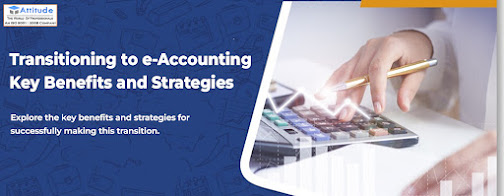Transitioning to e-Accounting: Key Benefits and Strategies
Introduction
In the constantly evolving
realm of finance and accounting, the shift towards e-accounting tools and the
adoption of digital financial management practices have transcended mere
choices; they've evolved into imperative steps for businesses striving to maintain
their competitive edge and operational efficiency in the contemporary era.
E-accounting tools and the
strategies for digital financial management hold the potential to dramatically
streamline financial processes, elevate data precision, and offer an array of
advantages capable of revolutionizing your business operations. In this blog,
we will delve into the core advantages and tactical approaches required to
execute this transition effectively.
Benefits of Embracing
E-Accounting:
Heightened Efficiency:
E-accounting tools are adept at automating routine tasks, significantly
reducing manual data entry, and mitigating the risk of human errors. This
newfound efficiency empowers finance teams to dedicate more time to analytical
endeavors and strategic decision-making.
Elevated Accuracy:
Digital financial management guarantees greater precision in financial data,
curtailing the potential for errors linked to manual calculations and data
handling. This heightened accuracy plays a pivotal role in both compliance and
well-informed decision-making.
Real-time Data Accessibility:
E-accounting facilitates instantaneous access to financial data, offering
immediate insights into your financial health. This agility equips businesses
to respond promptly to market fluctuations and seize emerging opportunities.
Cost Economies:
Transitioning to financial management often leads to cost savings by
diminishing the reliance on physical storage, paper-based transactions, and the
extensive labor hours traditionally devoted to accounting processes.
Enhanced Security:
E-accounting systems frequently incorporate robust security features designed
to safeguard sensitive financial data. This safeguarding becomes particularly
crucial in an age where cybersecurity threats are mounting.
Scalability:
financial management tools can be tailored to align with the size and
complexity of your business. As your enterprise expands, these systems exhibit
the adaptability to accommodate your evolving needs.
Strategies for a Seamless
Transition:
Goal Definition:
Prior to integrating e-accounting tools, it is essential to establish
unequivocal objectives. Identifying what you wish to accomplish, whether it's
reducing processing time, enhancing reporting, or fortifying compliance, is the
cornerstone of a successful transition.
Current Process Evaluation:
Carefully assess your existing accounting processes to pinpoint areas that
stand to gain from automation and digital solutions. An in-depth understanding
of your current workflows is a prerequisite for a smooth transition.
Tool Selection: When
choosing e-accounting tools and digital financial management systems, it's
paramount to align them with your business's unique needs and objectives.
Factors such as scalability, user-friendliness, and integration capabilities
should be meticulously considered.
Training and Onboarding:
Furnish comprehensive training and support to your finance team to ensure their
comfort with the new tools. This proactive approach can minimize resistance to
change and expedite the adoption process.
Data Migration:
Devise a well-structured data migration plan to ensure the seamless transfer of
all historical financial data to the new system, preserving the integrity of
your financial records.
Security Protocols:
Implement robust security measures to shield sensitive financial data from
cyber threats and unauthorized access. This step is indispensable for upholding
trust and compliance.
Continuous Monitoring: Routinely
monitor the performance of your e-accounting tools and financial management
systems. Verify that they are aligned with your objectives and are being
maximized to their full potential.
In Conclusion:




Comments
Post a Comment